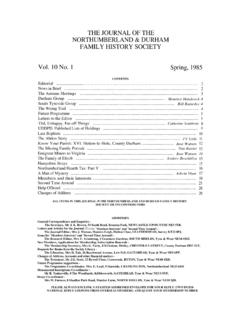Transcription of The ZEITGEIST Sourcebook - Stellar House Publishing
1 The ZEITGEIST Sourcebook Part 1: The Greatest Story Ever Told Peter Joseph and Murdock Preface As one of the main sources for the religion part of the first ZEITGEIST film, which has been viewed evidently over 100 million times worldwide, I have spent the past several years defending this Part 1 and bringing forth its sources into the light of day. I have written not only a number of articles and ebooks but also a nearly 600-page book, Christ in Egypt: The Horus-Jesus Connection, elucidating upon these sources, highlighting the very profound correspondences between Christianity and the ancient Egyptian religion. I have also done a number of videos and audio recordings on this subject as well. When Peter Joseph asked me to help out on this lengthy project, I readily agreed, even though the material contained herein had already been validated repeatedly in my other efforts.
2 In this day and age, it is obvious that many people are not inclined or available time wise to read large tomes of scholarly writings in order to figure it all out. This fact of time-constraint as well as difficulty in subject matter is the major reason ZEITGEIST was so successful in the first place, as it provided a short and easily digestible summary of the issue at hand: To wit, the origins of some of our most cherished religious ideas. So, here we have put together a resource that is hopefully more readily available to all who are interested but find it difficult and time-consuming to wade through huge chunks of information. When Peter first asked me to pitch in on this specific project, he was not aware of how much work it would turn out to be, because as many who have read my work will know I am very diligent and meticulous in not only my writing style but also the subject matter. In any event, as I try to do, I have put my all into this work, so I hope you will benefit from it greatly.
3 This effort includes much new source material drawn from primary sources as well the works from credentialed authorities in a variety of relevant subjects. Indeed, I have strived to include the best and most thorough, scholarly and modern sources wherever possible, with the result that many authorities cited here possess credentials from respected institutes of higher learning, and their publishers are some of the most scholarly in English (and other languages), such as: Brill Peeters Kegan Paul Oxford University/Clarendon Press Princeton University Press Cambridge University Press Cornell University Press Yale University Press University of Chicago Press University of Pennsylvania Press University of Wisconsin Press Johns Hopkins Press Harcourt, Brace & Co. MacMillan & Co., etc. This Sourcebook thus provides relevant primary-source material and citations from respectable and credentialed authorities, along with germane images to support the first part of ZG s contentions.
4 There are over 150 sources cited in this Sourcebook , in nearly 350 footnotes. The ZEITGEIST Sourcebook : Part 1 The Greatest Story Ever Told ii This Sourcebook is set up with the quotes from the movie numbered and bolded, followed by relevant commentary from primary sources and authorities, as well as pertinent images that total some 80 throughout the work. Please remember that I have composed only the first part of the complete Companion Source Guide that Peter Joseph has posted on his website the part of which I am providing here as the Sourcebook whereas he wrote the rest of it. I am likewise only responsible for certain aspects of the first or religion part of ZEITGEIST and have no input into the rest of the film or, again, its part of the ZG Companion Source Book. Nor am I directly involved in the ZEITGEIST Addendum or Venus Project. Enjoy! Murdock aka Acharya S USA, August 2010 The Greatest Story Ever Told 1.
5 This is the sun. As far back as 10,000 , history is abundant with carvings and writings reflecting people s respect and adoration for this object. Numerous artifacts prove these points, such as from the sun-worshipping cultures of the Egyptians, Indians, Babylonians and Greeks, among many others, including the peoples of the Levant and ancient Israel. Concerning the antiquity of sun worship, UNESCO Goodwill Ambassador Dr. Madanjeet Singh relates: The tool-making hominids, as anthropologists call them, emerged about one-and-a-half million years ago. But the sun s identification with the animals they hunted became evident much later as in the striking circular engravings representing the sun, discovered in the Central Asian regions (thirteenth millennium BC) in Siberia and western Turkistan. They seem to have eventually influenced the earliest artifacts made in Iran and Apart from the animals depicted in the Lascaux caves in France, at Altamira in Spain, at Adduara in Sicily (15,000 to 10,000 BC), and at the prehistoric Tassili N Ajjer in the Sahara region (7000 to 4000 BC), are also strange human figures such as the dancing man with horns on his head and a stallion tail, as in the cave paintings at Trois Fr res in Ari ge.
6 These are comparable to similar figures seen on the third-millennium-BC Mohenjo-daro seals found in the Indus Valley symbols that are identified with the Describing this ubiquitous of sun worship, professor of Archaeology at Cardiff University Dr. Miranda J. Aldhouse-Green remarks: The evidence for the sun cult manifests itself in Europe from as long ago as the fourth millennium BC, when Neolithic farmers recognized the divine power of the solar ..Solar religion manifested itself not only in acknowledgement of the overt functions of the sun as a provider of heat and light but also in recognition of influences that were more 1 Singh, 12-13. The ZEITGEIST Sourcebook : Part 1 The Greatest Story Ever Told 2 To early communities, the sun was an enigma, with its nightly disappearance from the sky and the withdrawal of its heat for half the year. The sun s value as a life-force was This solar religion continued for millennia, well into the common or Christian era.
7 As stated by Dr. Lee Levine, a professor at the Jewish Theological Seminary: On the religious plane, belief in the supremacy of the sun god was widespread. The cult of Mithra, as well as other Oriental cults in the late Roman era, identified the supreme deity with the sun. In fact, the tendency in Late Antiquity to unify the creeds allowed [the Greek sun god] Helios to be identified in many circles as the highest deity. On an intellectual level, Neoplatonic thought throughout these centuries likewise addressed the centrality of the Closer to Palestine, sun-worship is amply Palmyra, among the Essenes, in Nabataea, as well as on a plethora of coins, statuettes, altars, busts, and inscriptions from the first centuries of our Dr. Levine also says: In the late Roman era, the figure of Helios, or Sol Invictus, occupied a central role in a variety of settings, from the Imperial circles of Rome to the eastern Throughout the Greco-Roman period generally, and especially in the first centuries of the Common Era, the cult of this sun god enjoyed enormous Sun worship persists to this day, as described in Dr.
8 Singh s The Sun: Symbol of Power and Life, an extensive survey with many images of solar religious traditions and iconography from the earliest periods into the modern era. For more information on the Astrotheology of the Ages and The God Sun, see also Suns of God: Krishna, Buddha and Christ Unveiled by Acharya Murdock. Anthropomorphized sun-god images in Saimaly Tash rock drawings Bronze Age (c. 3000-600 BCE) Tien Mountains, Kyrgyzstan (Singh, 15) Babylonian King before the Sun God Shamash, c. 2000 BCE (Mus e du Louvre, Paris) Irish Sun Disc c. 2000 BCE (N. Museum of Ireland, Dublin) 2. And it is simple to understand why, as every morning the sun would rise, bringing vision, warmth, and security, saving man from the cold, blind, predator-filled darkness of night. Without it, the cultures understood, the crops would not grow, and life on the planet would not survive.
9 These realities made the sun the most adored object of all time. Concerning the ancient reverence for the sun, UNESCO Director-General Dr. Federico Mayor remarks: As the bestower of light and life, ancient cultures generally identified the sun as the symbol of Truth, the all-seeing one eye of justice and equality, the fountainhead of 2 Singh, 295. 3 Kalmin, 106. 4 Kalmin, 103. The ZEITGEIST Sourcebook : Part 1 The Greatest Story Ever Told 3 wisdom, compassion, and enlightenment, the healer of physical and spiritual maladies, and, above all, the fundamental source of fecundity, growth, and fruition, as well as of death and the renewal of An Egyptian hymn from the era of the pharaoh Akhenaten (d. c. 1336 BCE) expresses the intense ancient reverence for the sun: You appear beautiful, You living sun, lord of Endless Time, are sparkling, beautiful and strong, Love of you is great and powerful.
10 Your rays touch every Your radiant skin animates hearts. You have filled the Two Lands [of the horizons] with love of Pharaoh Akhenaten and wife Nefertiri worshipping the sun c. 14th century BCE 3. Likewise, they were also very aware of the stars. Naturally, the ancient practice of astrotheology incorporated reverence for not only the sun but also the moon, planets, stars and constellations. In Prehistoric Lunar Astronomy, Indian scholar Dr. Roy remarks: To the was the land of gods and mystery. The itself living. The stars were the abode of the gods. The shining stars were indeed themselves luminous gods. Astronomy was the knowledge not of heavenly bodies, but of heavenly beings: It was the heavenly, celestial cosmic or divine knowledge knowledge of devas the bright luminous Ancient Stellar symbols and star maps have been found dating to many thousands of years ago, including in cave paintings and carvings.







